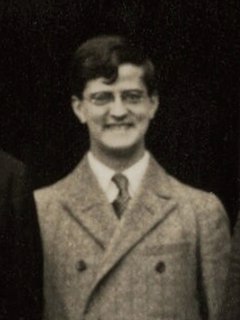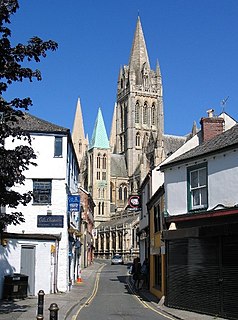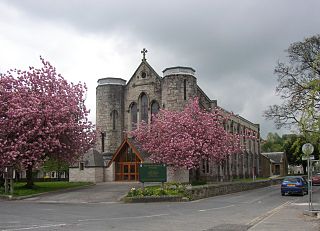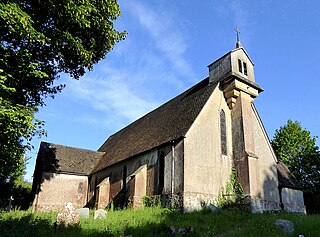
Alfred Leslie Rowse was a British historian and author, best known for his work on Elizabethan England.

The Cathedral of the Blessed Virgin Mary, Truro is a Church of England cathedral in the city of Truro, Cornwall. It was built between 1880 and 1910 to a Gothic Revival design by John Loughborough Pearson on the site of the parish church of St Mary. It is one of only three cathedrals in the United Kingdom with three spires.

St Austell is a town in Cornwall, England, UK, 10 miles (16 km) south of Bodmin and 30 miles (48 km) west of the border with Devon.

Charlestown is a village and port on the south coast of Cornwall, United Kingdom, and in the civil parish of St Austell Bay. It is situated approximately 2 miles (3 km) south east of St Austell town centre.

St Bartholomew's Church is a parish church of the Church of England Diocese of Truro in Lostwithiel, Cornwall, England, United Kingdom.

St Peter's Church is in Middlewich Road, Minshull Vernon, Cheshire, England. It is an active Anglican parish church in the deanery of Nantwich, the archdeaconry of Macclesfield, and the diocese of Chester. Its benefice is combined with that of St Leonard, Warmingham. The church is recorded in the National Heritage List for England as a designated Grade I listed building. It was a Commissioners' church, having received a grant towards its construction from the Church Building Commission.

St George's Church is in Castle Street, Kendal, Cumbria, England. It is an active Anglican parish church in the deanery of Kendal, the archdeaconry of Westmorland and Furness, and the diocese of Carlisle. Its benefice is united with those of St Oswald, Burneside, St John, Grayrigg, St Mary, Longsleddale, St Thomas, Selside, and St John the Baptist, Skelsmergh, to form the Beacon Team Ministry. It was a Commissioners' church, having received a grant towards its construction from the Church Building Commission.

Saint Helen's Church, also often incorrectly known as Saint Helena's Church, is an Anglican church on the 445 ha island of Lundy, lying at the mouth of the Bristol Channel, 19 km (12 mi) off the north coast, and part of the county, of Devon in England. As there is no resident priest on the island, the church is only irregularly used to hold services, though it is open to visitors. It is part of the Diocese of Exeter.

St Just's Church, St Just in Roseland, is a Grade I listed parish church in the Church of England Diocese of Truro in St Just in Roseland, Cornwall, England, UK.

The Church of St John the Baptist is the Anglican parish church for the village of Bishop's Tawton in Devon. The church has been a Grade I listed building since 1965 and comes under the Diocese of Exeter.

St Andrew's Church is a Church of England church in Monkton Wyld, Dorset, England. It was built in 1848–49 to the designs of Richard Cromwell Carpenter and has been a Grade II* listed building since 1960.

St James' and St Anne's Church is a Church of England church in Alfington, Devon, England. It was built in 1849 at the expense of Sir John Taylor Coleridge and designed by William Butterfield.

Holy Trinity Church is a Roman Catholic and former Church of England church in Dorchester, Dorset, England. Built in 1875–76 to the designs of Benjamin Ferrey, it was declared redundant by the Church of England in 1975 and reopened the following year as a Roman Catholic church. It has been a Grade II listed building since 1975.

St Germanus' Church is a Church of England church in Rame, Cornwall, England, UK. Much of the existing church dates to the 13th and 15th centuries. It has been Grade I listed since 1960.

St Mary's and St Julian's Church is a Church of England parish church in Maker, Cornwall, England, UK. The church dates to the 15th century and has been a Grade I listed building since 1968.

All Saints Church is a Church of England parish church in Millbrook, Cornwall, England, UK. It was built in 1893–95 and has been Grade II listed since 1987. The war memorial on the edge of the church grounds also became Grade II listed in 2016.

The Church of St John the Evangelist is a Church of England church in Clevedon, Somerset, England. Designed by William Butterfield, it was built in 1876–78 at the expense of Sir Arthur Elton and has been a Grade II* listed building since 1976.

Christ Church is a Church of England, Evangelical parish church in Paignton, Devon, England. Designed by Walter G. Couldrey and Edward Gabriel, the church was built in 1887–88 and has been a Grade II listed building since 1993.

The Church of St John the Evangelist is a Church of England parish church in Tatworth, Somerset, England. It was built in 1850–51 to the design of Charles Pinch of Bath and is a Grade II listed building.
Theophilis Glascott Vawdrey L.R.C.P., M.R.C.S. was an English physician, surgeon and anti-vivisection activist.



















